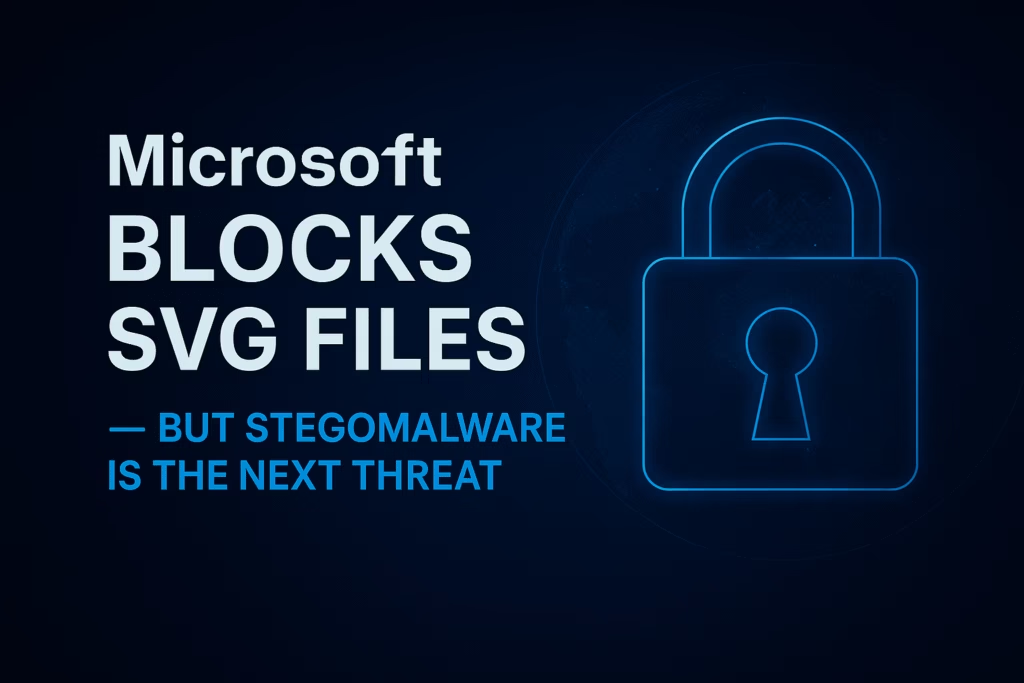Microsoft Blocks SVG Files in Outlook
But Stegomalware is the Next Threat

Microsoft’s Move Against SVG-Based Attacks
Microsoft has announced that Outlook for Web and the new Outlook for Windows will stop displaying inline SVG (Scalable Vector Graphics) images to reduce abuse of embedded code (for example, malicious JavaScript) that can enable XSS (Cross-Site Scripting)BleepingComputer, Bitdefender, and TechRadar Pro.
Because SVG is an XML-based text format, attackers can hide script handlers and dynamic behaviors inside what appears to be a harmless image. Disabling inline SVG rendering removes a common phishing pathway inside email bodies while still allowing SVG as a normal file attachment.
The Next Frontier: Stegomalware in PDF and DOCX
With inline SVG restricted, adversaries will continue to pivot. A rising risk is steganography inside document formats. When steganography is used to conceal malware within everyday files like PDF and DOCX, we refer to the resulting threat as stegomalware — hidden payloads or command instructions embedded in metadata, images, whitespace, or XML parts of a document that can evade traditional scanning. (Yes, you’ll even see some people misspell it “makware”; we mean malware.)
Why This Is Dangerous — Even Without Opening the File
- Cloud exposure: Many email platforms auto-store attachments in cloud mailboxes. Vulnerable preview or rendering services may process a malicious PDF or DOCX even before a user opens it.
- Silent backdoors and data theft: Crafty files can exploit parsing bugs to establish a backdoor or exfiltrate data straight from the email/storage tier.
- Stealth: Hidden content doesn’t look like a macro or a known exploit. Signature-based antivirus may miss it.
How Stegomalware Fuels Phishing
Attackers send convincing “invoices,” “resumes,” or “reports.” The PDF/DOCX looks routine, but a concealed payload activates when parsed locally or by a vulnerable cloud renderer. This blend of social engineering and hidden code raises the baseline risk for Cybersecurity across enterprises and small businesses alike.
What Microsoft and the Industry Should Do Next
- AI-powered steganalysis: Train models to spot anomalous structures and encoded streams in PDF/DOCX.
- Entropy & metadata heuristics: Flag irregular compression, embedded objects, and suspicious XML parts.
- Behavioral sandboxing: Render documents in isolated containers and monitor outbound calls, process spawns, and file writes.
- Zero-trust attachment handling: Quarantine on arrival, re-scan on access, and strip/neutralize active content where possible.
Bottom Line
Blocking inline SVG files in Microsoft Outlook is a smart mitigation, but defenders must assume attackers will hide in “safe-looking” formats next. Treat attachments with caution, enforce layered controls, and invest in detection that can see the invisible — especially within PDF and DOCX files.
Sources
- Microsoft Outlook stops displaying inline SVG images used in attacks — BleepingComputer
- Microsoft Outlook blocks inline SVG images to curb security threats — Bitdefender
- Outlook will no longer show inline SVG images exploited in phishing — TechRadar Pro
